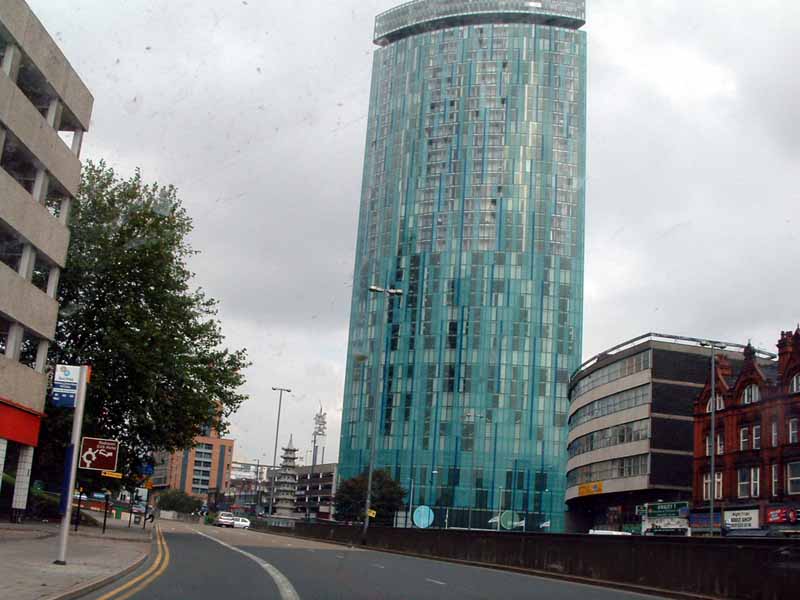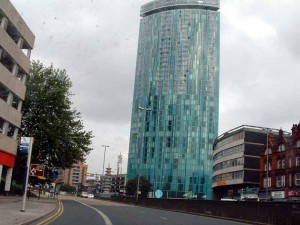By Alan Clawley.
One way in which Birmingham’s civic and business leaders want to boost the image of the city centre is to build tall buildings, mainly office blocks, on the highest land that the council likes to call ‘The Central Ridge’. The idea is enshrined in a policy entitled ‘High Places’ published by the planners in 2002. In it a number of spots are marked on a map where the planners would like to see buildings up to 30 floors high, the maximum permitted by Birmingham Airport. One of these spots is Paradise Circus, site of the condemned Central Library.
The policy was, to quote, “…prompted by developers’ renewed interest in tall buildings after a lengthy period when no new proposals had been contemplated by the City.” It goes on to explain that “…media and public interest in tall buildings following the terrorist attacks on the World Trade Centre in New York has caused some people to doubt the wisdom of building them, nevertheless they are a legitimate building form and it would seem inappropriate to react to such unprecedented events by outlawing them. They are widely accepted as symbols of the commercial success of modern cities…”
The planners show photographs of the best views of the Central Ridge from five “key” locations that most of us will never visit. We can’t view the city centre from a train passing through Adderley Park, or stop to admire its splendours from a car on the Small Heath Highway and few of us will want to gaze at its distant beauty when having a picnic in Kingston Local Park. These viewpoints will never be marked on tourist maps where coach parties will stop for photographs. They are nothing more than locations for council photographers to capture images for promotional brochures. What developer will bother to check how a new office block will look from Park Circus over the Aston Expressway?
The grand plans of the city fathers tend to be over-ambitious and delusional and ‘High Places’ is no exception. For a start the ‘Central Ridge’ is a fantasy. It is not a free-standing ridge viewable from all points of the compass. It is merely the lowest, most easterly section of a spur that comes down from the highest point of 236 metres just west of Warley Woods Golf Course on the Main English Watershed. The section of spur occupied by the Central Ridge covers only the contours between 150 metres and 120 metres. The highest ground, no doubt long envied by the council, is west of Five Ways where the Calthorpe family owned 1600 acres and clearly knew what they were doing when they settled there. It’s the best part of the city in which to live and work being leeward of the smoky industry of Digbeth and Witton.
The planners had to strain to construct their favourite views of the Central Ridge. The five key viewpoints are limited to locations across the valley of the Rea from high ground to the south and east of the Central Ridge. The view from Edgbaston Reservoir, for example, at 160 metres, is disappointing because the city centre is beyond and below the dam. From Warley Woods the line of tower blocks along the spur would be seen end-on and therefore too close together to impress by sheer numbers.
Even if High Places was a good idea it could only be realised if and when the commercial property market, especially for grade A office space, was in full flow. Now that cannot be taken for granted. Arena Central, which was to be Birmingham’s tallest building, planned for the former ATV studies behind the old Municipal Bank on Broad Street and on the highest part of the central Ridge, is held up indefinitely. The tower planned to replace Madin’s NatWest building on Colmore Row, again on the Central Ridge, shows no signs of progress. Further down the Central Ridge at Snow Hill, tall buildings lie unfinished. Paradise Circus, a prime location for a tall building in High Places lacks reality and its value has been gradually reduced from £1billion to £600 million to £500 million as the property market collapsed. Only the Beetham Tower on Holloway Head has made it despite not being on the Central Ridge at all.
So much for Grand Plans. They take so long to complete that fashions change or markets collapse and they are discarded. Baskerville House was part of a plan for a huge civic centre that was never finished because of war. The plan for Paradise Circus which included Madin’s Central Library was meant to include a bus station and a sports institute and to bring in the idea of raising pedestrians on platforms above the traffic. But that fell victim to the 1974 rise in oil prices and council cutbacks. The Inner Ring Road, once the proud “Queensway” and more recently re-named the “Concrete Collar” has been partly demolished and the concept discredited.
It is time for High Places to be abandoned too. Paradise Circus does not need an overbearing tower block. Central Birmingham, like other parts of the city should be planned for the human scale and not on the basis of the romantic notion of ‘towers-on-a-hill’. High Places should be scrapped before a megalomaniac of an elected mayor seizes on it as an opportunity to build his or her lasting legacy. But it may already be too late as Mike Whitby’s Library of Birmingham soars above its older neighbours in Centenary Square, bringing renewed hope to those who still dream of commanding the heights of the Central Ridge.

